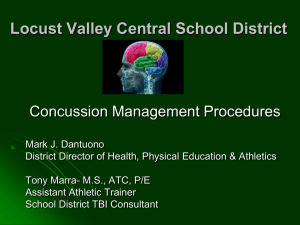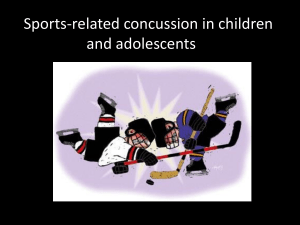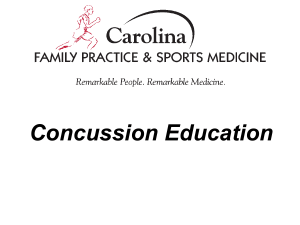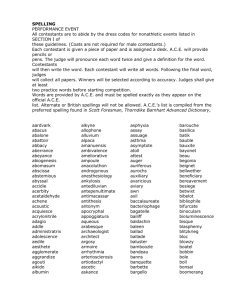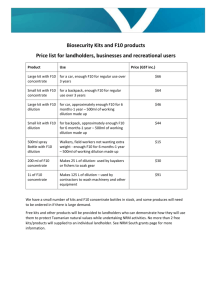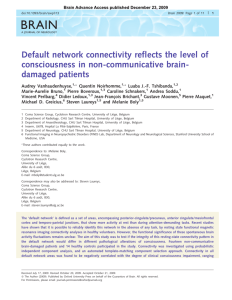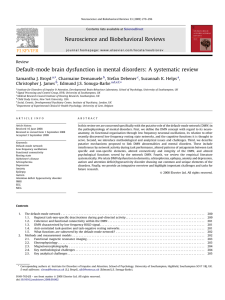The Dynamically Changing Default-Mode Network after Concussion
advertisement
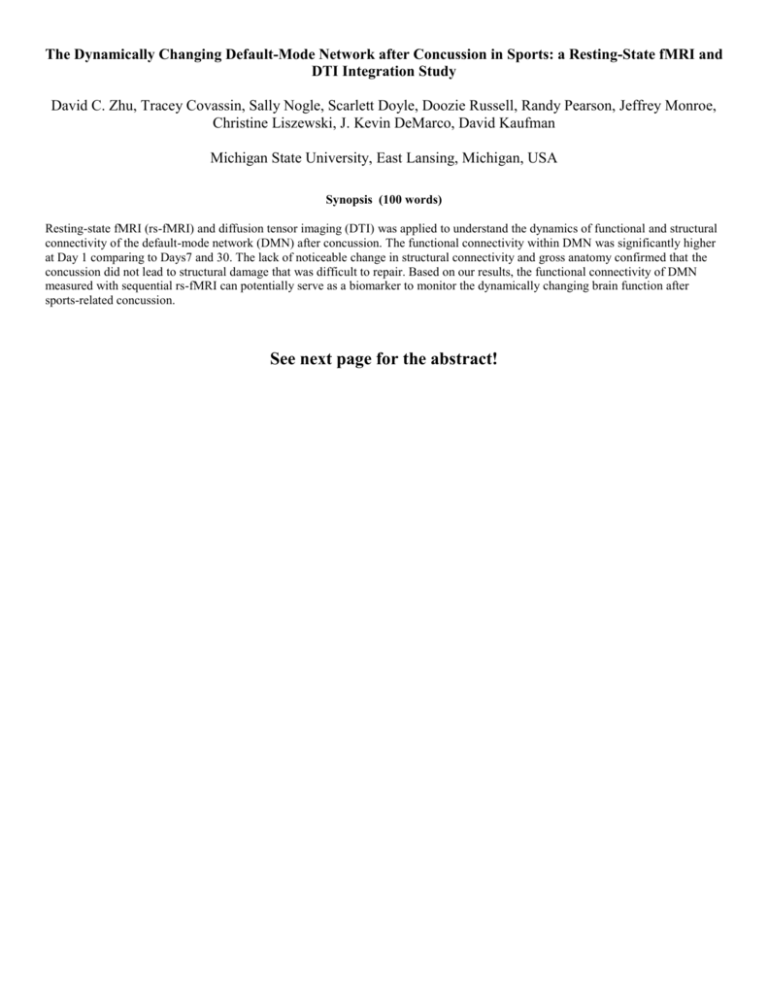
The Dynamically Changing Default-Mode Network after Concussion in Sports: a Resting-State fMRI and DTI Integration Study David C. Zhu, Tracey Covassin, Sally Nogle, Scarlett Doyle, Doozie Russell, Randy Pearson, Jeffrey Monroe, Christine Liszewski, J. Kevin DeMarco, David Kaufman Michigan State University, East Lansing, Michigan, USA Synopsis (100 words) Resting-state fMRI (rs-fMRI) and diffusion tensor imaging (DTI) was applied to understand the dynamics of functional and structural connectivity of the default-mode network (DMN) after concussion. The functional connectivity within DMN was significantly higher at Day 1 comparing to Days7 and 30. The lack of noticeable change in structural connectivity and gross anatomy confirmed that the concussion did not lead to structural damage that was difficult to repair. Based on our results, the functional connectivity of DMN measured with sequential rs-fMRI can potentially serve as a biomarker to monitor the dynamically changing brain function after sports-related concussion. See next page for the abstract! TARGET AUDIENCE: Neuroimaging researchers/clinicians in concussion/traumatic brain injury BACKGROUND: Current diagnosis and monitoring of concussion/mild traumatic brain injury (mTBI) rely on signs and symptoms, balance, vestibular, and neuropsychological examination. Conventional brain imaging often does not reveal abnormality. Recent work by Johnson et al. (1) demonstrated the alteration of default-mode network (DMN) with resting-state fMRI (rs-fMRI) in the sub-acute phase after concussion. To further understanding the recovery process, in this pilot work, we assessed the dynamic change of DMN connectivity with rs-fMRI and diffusion tensor imaging (DTI) on days 1, 7 and 30 after concussion. METHODS: Eight male intercollegiate concussed athletes (20 ± 1.3 years old, one repeated case) and 11 male control subjects (20.5 ± 1.8 years old) participated in this study. ImPACT (Immediate Post-Concussion Assessment and Cognitive Testing) procedure was administered over the course of recovery. High-resolution 3D T1weighted, T2*-weighted, DTI and rs-fMRI brain images were collected on a GE 3T Signa® HDx MR scanner from each subject within 1 day, on 7 ± 1 days and then 30 ± 1 days after concussion. The rs-fMRI included two 7-min resting-state (relax, eyes closed but staying awake) EPI datasets with the following parameters: 38 contiguous 3-mm axial slices, TE = 27.7-ms, TR = 2500-ms, flip angle = 80°, field of view (FOV) = 22 cm × 22 cm and matrix size = 64×64. DTI images were Day 1 acquired with a dual spin-echo EPI sequence for 12 min and 6 sec with the following parameters: 48 contiguous 2.4-mm axial slices in an interleaved order, FOV = 22 cm × 22 cm, matrix size = 128 × 128, number of excitations = 2, TE = 77.5 ms, TR = 13.7 s, 25 diffusion gradient direction with b = 1000 s/mm2, one volume with b = 0 and parallel imaging acceleration factor = 2. For each subject, correlation analyses of rs-fMRI were carried in AFNI (2). Slice-timing and motion corrections were applied. Baseline, linear and quadratic system trends were removed. Brain global, cerebral spinal fluid and white matter mean signals were modeled as nuisance variables and were removed from the time courses. Band-pass filter in the range of 0.009 Hz – 0.08 Hz was applied. Voxel-based correlation was done on every voxel of the brain against Day 7 the time course from the average signal within a seed region. The right and left isthmi of cingulate cortex (ICCs), which are within the key hub regions of DMN (3), were defined with FreeSurfer (4) as these seed regions. Correlation analysis results from individual subject were warped to Talairach template for group analyses. In each group, full-brain ANOVAs were carried to compare the functional connectivity changes between the three time points. DTI was analyzed with FSL Diffusion Toolbox with the adjacent whitematter region of ICCs as seeds (5). The anatomical images and DTI-based structural connectivity were Day 30 reviewed for potential structural changes. RESULTS: ImPACT showed significant decline of cognitive scores across multiple categories and a significant increase of symptom score on Day 1 following a concussion, with a full recovery after 5 ± 2.4 days. While the structural connectivity within DMN and gross anatomy appeared unchanged, a significantly Fig.1. Mean functional connectivity to left isthmus of cingulate reduced functional connectivity to ICCs within DMN from Day 1 to 7 was seen in the concussed group (P < cortex (ICC) of concussed group (correlation R > 0.25, n = 8). 0.028, whole-brain corrected) based on the ANOVAs within the concussed group, notably around anterior cingulate, medial frontal, superior frontal, middle temporal/angular and hippocampus/parahippocampal gyri (Fig. 1). This reduction trend was seen in eight of our nine concussion cases (Fig. 2). There was also a trend of improved DMN functional connectivity from Day 7 to 30. ANOVAs of the control group did not find significant brain alteration of DMN over the one-month period. DISCUSSION AND CONCLUSION: The dynamically changing functional connectivity of DMN appears corresponding to the tri-phase neurometabolic cascade following a concussion based on animal models (6). The heightened connectivity of the DMN on Day 1 seems reflecting the abrupt and indiscriminant release of neurotransmitters and ionic influxes, and the accelerated glucose metabolism, which in turn leads to the significant decline of cognitive scores. Node-based functional network analyses are on-going to further support the conclusion from whole-brain analyses. The lack of noticeable change in structural connectivity and gross anatomy confirmed that the concussion did not lead to the structural damage that was difficult to repair. Based on our results, the functional connectivity of DMN measured with sequential rs-fMRI can potentially serve as a biomarker to monitor the dynamically changing brain function after sports-related concussion. Day 1 Day 7 Day 30 structural functional Fig.2. Case study: The functional (in green and red) and structural (in orange and red) connectivity to left isthmus of cingulate cortex of a concussed subject over one month (correlation R > 0.4 and connectivity distribution > 1000). Red: overlap regions. REFERENCES: 1. Johnson B, Zhang K, Gay M, Horovitz S, Hallett M, Sebastianelli W, Slobounov S. Alteration of brain default network in subacute phase of injury in concussed individuals: resting-state fMRI study. Neuroimage 2012;59(1):511-518. 2. Cox RW. AFNI: software for analysis and visualization of functional magnetic resonance neuroimages. Comput Biomed Res 1996;29(3):162-173. 3. Buckner RL, Andrews-Hanna JR, Schacter DL. The brain's default network: anatomy, function, and relevance to disease. Ann N Y Acad Sci 2008;1124:1-38. 4. Fischl B, Salat DH, Busa E, Albert M, Dieterich M, Haselgrove C, van der Kouwe A, Killiany R, Kennedy D, Klaveness S, Montillo A, Makris N, Rosen B, Dale AM. Whole brain segmentation: automated labeling of neuroanatomical structures in the human brain. Neuron 2002;33(3):341-355. 5. Behrens TE, Berg HJ, Jbabdi S, Rushworth MF, Woolrich MW. Probabilistic diffusion tractography with multiple fibre orientations: What can we gain? Neuroimage 2007;34(1):144-155. 6. Giza CC, Hovda DA. The Neurometabolic Cascade of Concussion. J Athl Train 2001;36(3):228-235.


